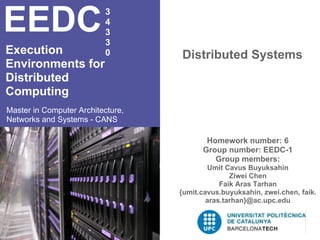
Warm up group6
- 1. EEDC 3 4 3 3 Execution 0 Distributed Systems Environments for Distributed Computing Master in Computer Architecture, Networks and Systems - CANS Homework number: 6 Group number: EEDC-1 Group members: Umit Cavus Buyuksahin Ziwei Chen Faik Aras Tarhan {umit.cavus.buyuksahin, zwei.chen, faik. aras.tarhan}@ac.upc.edu
- 2. OUTLINE ● Concepts of Distributed System ○ Definition ○ Brief history ○ Goals ○ Architecture ● Centralized & Decentralized Systems ● Differences from centralized & decentralized systems ○ Differences from centralized system ○ Differences from decentralized system ● Examples ● Conclusion
- 3. Definition ● A distributed system is a piece of software that ensures that: a collection of independent computers appears to its users as a single coherent system. ● Two aspects: (1) Independent computers and (2) single system => middleware.
- 4. Brief history ● 1945 ~ 1985 ○ ... computers were large and expensive ○ ... no way to connect them ○ ... all systems were Centralized Systems. ● Mid 1980s ○ ... powerful microprocessors. ○ ... high Speed Computer Networks (LANs, WANs). ● Then Distributed System came
- 5. Goals ● Resource Sharing ○ ... with Distributed Systems, it is easier for users to access remote resources and to share resources with other users. ● Openness ○ ... the openness of DS is determined primarily by the degree to which new resource-sharing services can be added and be made available for use by a variety of client programs. ● Transparency ○ ... it hides the fact that the processes and resources are physically distributed across multiple computers. ● Scalability ○ ... a system is described as scalable if it remains effective when there is a significant increase in the number of resources and the number of users. ● Concurrency ○ ... there is a possibility that several clients will attempt to access a shared resource at the same time.
- 6. Architecture A distributed system organized as middleware The middleware layer extends over multiple machines, and offers each application the same interface.
- 7. Centralized & Decentralized Systems ● Centralized Systems ○ ... designed around a central workstation (+) simple and ease to maintain (-) non-scalable, single point of failure ● Decentralized Systems ○ ... have exact opposite characteristics of centralized sys. (+) self-regulating, faster decision, scalability (-) difficult to manage
- 8. Differences From Centralized Systems ● Concurrency ... runs in concurrent processes on different processors ● Authority ... gives less authority to make decision ● Interaction ... more interaction between parts of organization ● Applicability ... best-suited to large industries and companies
- 9. Differences From Centralized Systems ● Communication ... from top to bottom, bottom to top as well as across ● Points of Control ... multiple points of control ● Points of Failure ... multiple points of failure
- 10. Differences From Decentralized Systems ● The difference is subtle. ● The terms are probably used more or less interchangeably by many. ● Decentralized systems ○ ...not necessarily 'distributed' ○ ... does not have spread of functionality ○ ... less resilient
- 11. Examples ● The world wide web – information, resource sharing ● Clusters, Network of workstations ● It is easier for users to access remote resources and to share resources with other users like ○ printers, files, Web pages, etc ● Distributed manufacturing system (e.g., automated assembly line) ● Network of branch office computers - Information system to handle automatic processing of orders ● Network of embedded systems ● New Cell processor (PlayStation 3)
- 12. Examples - Internet ● The Internet is a vast interconnected collection of computer networks of many different types. [Coulouris et al, p.3] ● World’s largest client/server application ● Giant virtual disk ● Giant hyperlinked document
- 13. Examples - Centralized & Decentralized ● Napster ○ on startup, client contacts central server ○ reports list of files to central server ○ return someone that stores the requested file ○ get the file directly from peer ● BitTorrent ○ run a tracker server to publish ○ contact centralized “tracker” server, get a list of peers
- 14. Examples - Centralized & Decentralized ● Gnutella ○ fully decentralized ○ search cost distributed ● FreeNet ● KaZaA ○ no dedicated server ○ not all peers are equal ○ on startup, client contacts a “supernode” ○ send query to supernode, supernodes flood query among themselves ● DHTs
- 15. References ● http://www.cis.upenn.edu/~lee/07cis505/Lec/lec-ch1- DistSys-v4.pdf ● http://www.linkedin. com/answers/management/planning/MGM_PLN/212509- 5526887 ● http://www.cs.ucl.ac.uk/staff/ucacwxe/lectures/ds98- 99/dsee3.pdf ● http://www.ehow.com/info_10037010_difference-between- centralized-distributed-management-system.html ● http://openp2p. com/pub/a/p2p/2002/01/08/p2p_topologies_pt2.html
